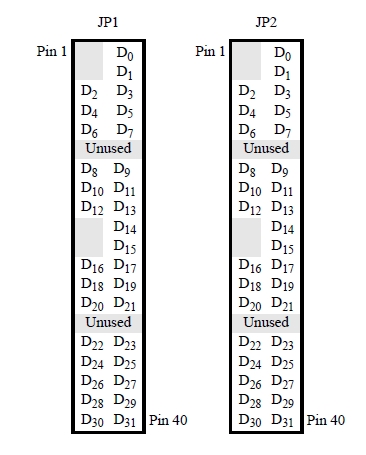
There are two General Purpose I/O (GPIO) Ports, each made of 32 bidirectional pins on the JP1 and JP2 40-pin expansion headers (hence the ports are each 32-bits wide). These ports can be used with some of the lab's peripherals such as the hexkeypad and Lego controller.
| Device | GPIO Port on JP1 & JP2 (can be used with hexkeypad, Lego, or digital protoboard) | |||||||||||||||
| Configuration | 32-bit wide bidirectional port | |||||||||||||||
| Input/Output | either | |||||||||||||||
| Address Base | JP1: 0xFF200060 and JP2: 0xFF200070 | |||||||||||||||
| Address Map |
| |||||||||||||||
| Initialization | Set direction register bits to input/output | |||||||||||||||
| Interrupts |
| |||||||||||||||
| Hardware Setup | Connect the 40-pin ribbon from the hexkeypad/lego controller/protoboard to either port JP1/2 on the DE1-SoC | |||||||||||||||
| Reference |
Hexkeypad Lego Controller |
Choosing a port - You can connect to either one of the 40-pin headers JP1 or JP2, they are both identical.
Acknowledging interrupts - Interrupts are triggered when any bit in the Edge Capture Register is high. So make sure you clear it before you enable interrupts and before you exit your interrupt handler.
The image below shows where on the 40-pin expansion ports you can find the 32 pins for JP1 and JP2.

.equ ADDR_JP1PORT, 0xFF200060 .equ ADDR_JP1PORT_DIR, 0xFF200064 movia r2,ADDR_JP1PORT_DIR movia r3,0xffffffff stwio r3,0(r2) # Set direction of all 32-bits to output movia r2,ADDR_JP1PORT movi r3,0xab stwio r3,(r2) # Write value to output pins
.equ ADDR_JP2PORT, 0xFF200070 .equ ADDR_JP2PORT_DIR, 0xFF200074 movia r2,ADDR_JP2PORT_DIR stwio r0,0(r2) # Set direction of all 32-bits to input movia r2,ADDR_JP2PORT ldwio r3,(r2) # Read value from pins
.equ ADDR_JP1PORT, 0xFF200060 .equ ADDR_JP1PORT_DIR, 0xFF200064 .equ ADDR_JP1PORT_IE, 0xFF200068 .equ ADDR_JP1PORT_EDGE, 0xFF20006C .equ IRQ_JP1PA, 0x00000800 movia r2,ADDR_JP1PORT_DIR stwio r0,0(r2) # Set all 32-bits to inputs movia r2,ADDR_JP1PORT_IE movi r3,0xf stwio r3,0(r2) # Enable interrupts on 4 LSB pins movia r2,IRQ_JP1PA wrctl ctl3,r2 # Enable bit 11 - button interrupts on Nios II movia r2,1 wrctl ctl0,r2 # Enable global Interrupts on Nios II
.section .exceptions, "ax" IHANDLER: rdctl et, ctl4 # Check if an external interrupt has occurred beq et, r0, SKIP_EA_DEC movia r7,IRQ_JP1PA # test for bit 7 interrupt and r7,et,r7 beq r7,r0,EXIT_IHANDLER # if not, exit handler movia r2,ADDR_JP1PORT ldwio r3,0(r2) # Read port A data /*** Do whatever you want with the data from the pins ***/ movia r7,ADDR_JP1PORT_EDGE stwio r0, 0(r7) # De-assert interrupt - write to edge capture reg EXIT_IHANDLER: subi ea,ea,4 # Replay interrupted instruction for hw interrupts SKIP_EA_DEC: eret
#define ADDR_JP1PORT ((volatile char *) 0xFF200060)
#define ADDR_JP2PORT ((volatile char *) 0xFF200070)
int main()
{
// init interface directions
*(ADDR_JP2PORT+4) = 0; //set every JP2 bit direction to input
*(ADDR_JP1PORT+4) = 0xffffffff; //set every JP1 bit dir to output
while (1)
{
*ADDR_JP1PORT = *ADDR_JP2PORT;
}
}